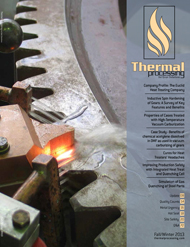In carburizing, gears must be heated to reach the appropriate temperature for the steel grade without causing excessive grain growth and distortion in a reasonable time; large loads take longer, small loads less time. Once at temperature, carbon must be introduced in a form and method that uniformly produces the required case depth and surface carbon, but not too high or too low. Finally, all gears in the entire load must be rapidly cooled, quenched to be specific; and, as explained in my Gear Solutions Hot Seat column, cooled in a manner that produces the hardness and strength for the material. Now for the rest of the story:
Driving to the office recently I listened to a very interesting but short radio interview of an automotive expert explaining what’s being developed for cars of the future, near and far. One of the challenging tasks he alluded to was the upcoming 54.5 MPG 2025 CAFE standards and the various solutions car companies are employing to meet it. Contained within his description was the disappointing issue of the driving public’s shunning of EV systems offered today, either all electric or hybrids. The phenomenon—like it or not—is what’s driving the rapid development of an advanced internal combustion [gasoline, natural gas or diesel] engine and associated double-digit speed transmissions. This development combined with the ever-increasing number of automobile models large and small is also changing the heat treating landscape and the need for a diverse “hardening” process based on the most cost effective solution for a particular application.
Automobile weight is the biggest obstacle to improving fuel mileage, and carmakers are researching all manner of nonferrous materials including composites, more use for aluminum and high strength plastics. Remember a few columns ago; much of the horsepower is consumed in moving the car from a standing start. Even subcompact cars with commensurately smaller gasoline or diesel engines consume more fuel during the launch. It’s no surprise then that for the car companies the easiest way to meet the 2025 standards is to produce smaller cars. And to satisfy the demand for these (smaller hopefully also means less expensive) many more models will likely be in demand, with more technology to make us think we’re getting more “bang for the buck.” Thus smaller and lighter vehicle transmissions won’t require the same load demand on gears, even the low speed gears as the larger vehicles, so shallower case depths will suffice. That means shorter carburizing times. But distortion controlled quenching will still be important, maybe even more so because the gears themselves will have less mass—thus possibly more machining; and thinner cross sections means more difficult distortion control. Thinner gears, less material between the OD and ID require better support especially as higher carburizing temperatures find acceptance; residual stress may become a bigger issue.
Carburizing to many may seem to garner the headlines all too often, but that’s because it has such a profound positive influence on the wear performance of steel and can be achieved at very low cost per gear.
Obviously, nitriding can contribute to improving the wear resistance of steel and will be required especially where distortion is most critical and sufficient quantities of gears can be processed economically. But not for the higher load situations, such as pickups and over-the-road haulers, due to the long processing times, and then there’s the material cost. FNC may seem to be a contender to replace carburizing and nitriding for that matter because of its shortened process time. However, FNC isn’t without its issues either, namely hard turning or grinding of harder gears. Gas nitriding because of the deeper case depth relies on a tempered hardness of 27 to 30 HRC—very easy to final machine with conventional tools.
Nitriding, gas or plasma takes place between 950°F [510°C] and 1025°F [552°C], where FNC requires temperatures about 1070°F [577°C] or higher.
At 1070°F [577°C] even for FNC’s short processing time of three to five hours can substantially reduce the hardness of the steel. FNC because it’s not intended to develop anything resembling a hardened case relies on the base material’s higher hardness to support the epsilon white layer. And to resist the driveline loads that carburized gears can easily withstand, a core hardness of at least 50 HRC will be required. As you may recall from previous columns an effective case depth [ECD] is the gold standard for strength in a carburized case. So FNC can require a higher-grade alloy steel thus more costly to maintain the 50 HRC hardness at the higher temperature. But perhaps as the transmissions become smaller and lighter the quantity of material per gear will be less, off-setting the higher material cost.
So what are transmission, gear designers and heat treaters to do to keep costs down yet excel at offering minimal distortion? And while increasing temperature can reduce carburizing time, heating large loads of gears can shield gears from radiation making uniform heating difficult and possibly add to distortion woes. So another “Holy Grail” of heat treating is processing one part at a time so each is subjected to an ideal thermal environment with uniform stress distribution; quenching and distortion control especially benefit. The answer I believe will be the adaptation of heretofore competing technologies like single part heating, endo carburizing for excellent surface carbon control and quenching gears one at a time. Heating and quenching gears one at a time is not a novel idea, it’s being done now but not in combination with carburizing. The 64 thousand dollar question is how to pull this off economically and offer flexibility.
One answer (although falling short of my ideal one-at-time philosophy) is provided by our sister company ALD-Holcroft by way of their SyncroTherm.® This unique vacuum and LPC system creates a more ideal heating and quenching environment by loading gears in one layer, thereby exposing the gears’ surface area to uniform radiation of upper and lower heating elements. In addition, by utilizing very thin low-mass carbon-carbon trays the overall mass quenched in six to 10 bar nitrogen is minimized. Figure 1 is a photograph of a typical SyncroTherm load arrangement.
Carburizing increases the wear and strength of a gear’s two critical stress regions, the PD and 60 degree angle from the root and will require very uniform quenching and very fast heat removal from the root to avoid bainite or at the very least reduce the quantity to manageable levels. When one witnesses through a viewport the high pressure gas quenching of stacked helical bevel gears such as automotive ring gears the problem becomes very apparent. As cooling starts, the tip of the teeth turn black first, as expected, and as cooling progresses to the PD, then the root, with the body of the gear taking much longer. The uniformity of cooling depends on the load density and shadowing—how closely the gears are located to each other.



























